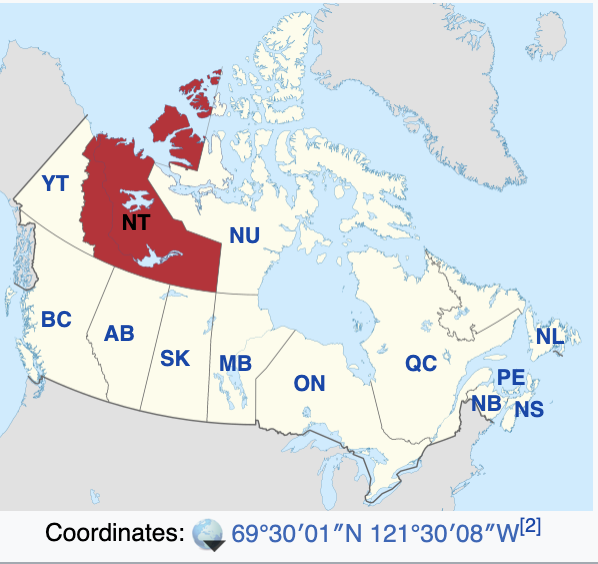
Soanes-White, T. (2022) Defining and exploring broadband connections and education solutions in Canada’s North Canadian Journal of Learning and Technology, Volume 48, No. 4
Note: this article contains some minor corrections to the original article published on January 4, 2023, for which I would like to thank Tammy Soanes-White.
This is a very interesting article that identifies clearly the challenges of providing digital learning in the (true) north of Canada.
The Northwest Territories
First it’s important to be clear about the nature of the challenge. The total population of the Northwest Territories is 45,000, of which almost half (20,000) live in the capital, Yellowknife.
However, NWT is very, very big in terms of space: the 25,000 living outside Yellowknife are spread across an area larger than the combined size of California AND Texas. Many of this 25,000 are in small communities strung along the very few roads that cross the NWT, mainly in the south, that connect to the rest of Canada. The rest live in fly-in communities, reached mainly by float plane to nearby lakes and/or by winter ice roads. Roughly half of the total population is indigenous (Dene, Inuit and Metis).
Online education in the NWT
The following regarding k-12 education in NWT is from CANeLearn, 2022:
There are 49 k-12 schools with a total population of 8,700 students. There is an e-learning program involving 92 students through Northern Distance Learning, based in Inuvik in the far north of the Territories, and another 124 students in grades 9-12 through an agreement with the Alberta Distance Learning Centre….
During the pandemic, the schools were closed in 2020. Students with limited access to the internet had paper-based assignments and for homes with access to the internet, suggested technologies were Google Classroom, Moodle, Facebook Live, GoToMeeting, Skype, and Zoom. Communication also consisted of local radio stations or telephone, and radio stations were made available to provide lessons through storytelling.
Aurora College has three campuses and 21 community learning centres throughout NWT, and is headquartered in Fort Smith. Aurora College and the francophone College Nordique Francophone are the only publicly funded post-secondary institutions in the NWT.
Aurora College offers six programs at a distance, using various delivery formats including: cohort-based, blended f2f and distance connections in Teams, teleconference, online, or a combination of these delivery approaches. Aurora College has been actively involved in distance education for the past twenty years.
There is no university based in the NWT, although Aurora College is in the process of transforming to become a polytechnic university.
Some students in NWT take university online courses from institutions outside NWT, such as Athabasca University in Alberta.
Internet access
Tammy Soanes-White provides a comprehensive overview of the challenge of Internet access in NWT. There are basically three types of broadband access currently available in the NWT suitable for digital learning:
- cable: co-axial, fibre or a mix (5 communities)
- digital subscriber lines (DSL): data over telephone cables, requiring a modem (20 communities)
- high orbiting satellite (9 communities).
There is also access in some communities for mobile phones, but not at the bandwidth required for extensive digital learning.
Soanes-White states though that from 2023, most communities connected by satellite will switch to low orbiting satellites, which will provide better connectivity. Soanes-White also states that digital subscriber lines do not provide adequate capacity for digital learning, especially for video or large data sets.
Consequences
Soanes-White states that ‘more equitable access to stable and consistent Internet is necessary to ensure that NWT residents have consistent access to post-secondary and higher education‘.
It is significant that the NWT is the only province or territory other than Nunavut (also in the far north) without online post-secondary degree courses. In both cases, Internet access is not sufficiently available across the territories for extensive digital learning. It is also significant that there is currently only one main service provider (NorthwestTel). However, there are smaller service providers including Indigenous and non-Indigenous businesses.
It is clear that it is difficult to make a business case from a telecommunications’ company point of view to increase bandwidth for such a small, widely dispersed audience. In effect we are talking about less than 25,000 people. However their right to digital education is just the same as anyone living in Toronto, Ottawa or Vancouver. This is a typical case where the state needs to step in. The Canadian federal government has pledged millions of dollars to improve Internet access in the North, but it is all being funnelled through existing telecom companies who have no motivation to improve access to what they consider to be marginal users.
It might be better then to offer the money directly to learners, by paying directly for bandwidth for educational and social purposes, and through grants to residents taking online courses, and to institutions to create them. If the telecom companies can see that revenues will increase, that in itself will act as motivation for creating better services.
It is nevertheless what is now known as a wicked problem – there is no easy solution. But thanks to Tammy Soanes-White for so clearly laying out the problem
Reference
CANeLearn (2022) State of the Nation: K-12 eLearning in Canada CANeLearn Halfmoon Bay BC









 Dr. Tony Bates is the author of eleven books in the field of online learning and distance education. He has provided consulting services specializing in training in the planning and management of online learning and distance education, working with over 40 organizations in 25 countries. Tony is a Research Associate with Contact North | Contact Nord, Ontario’s Distance Education & Training Network.
Dr. Tony Bates is the author of eleven books in the field of online learning and distance education. He has provided consulting services specializing in training in the planning and management of online learning and distance education, working with over 40 organizations in 25 countries. Tony is a Research Associate with Contact North | Contact Nord, Ontario’s Distance Education & Training Network.

